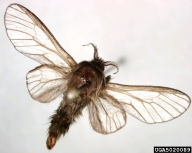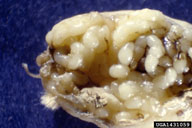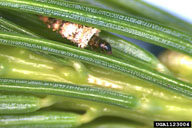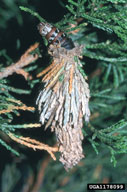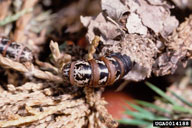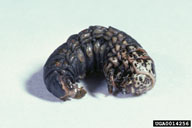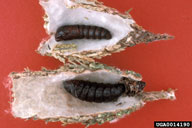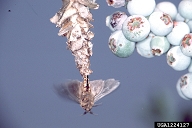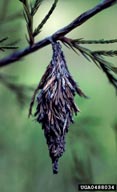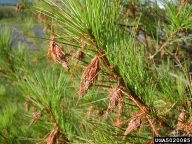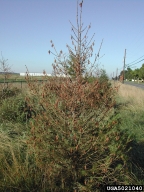Bagworm
Thyridopteryx ephemeraeformis (Haworth) (Lepidoptera: Psychidae)
Orientation to pest
Bagworm, Thyridopteryx ephemeraeformis (Haworth), is native to North America and larvae defoliate arborvitae (Thuja occidentalis L.), juniper (Juniperus virginiana L.), eastern white pine (Pinus strobus L.), and blue spruce (Picea pungens Engelm.), on which they are often abundant. Male moths have wings but females are wingless and are unable to move. Males and females emerge in the fall and males fly to females. Females never emerge from their larval shelters (the "bag"), and mate while still in their bags. Females then develop their eggs, which are laid inside the bag and these are the overwintering stage. Eggs hatch in spring and some larvae spin silk threads and are blown by the wind. Upon alighting on plants, neonate larvae accept or reject plants, and if the latter spin a new thread and repeat the dispersal process. Many larvae, however, skip this dispersal phase and settle on their natal plants. Once a larva has accepted a plant, it constructs a bag and drag it around as it feeds. Mature larvae attach their bags to the plant and pupate inside them. There is one generation per year. Bagworms can be locally dense on ornamental plantings, causing defoliation and killing trees or shrubs. Damage to forest stands is not usually important, because larvae prefer sunny sites. Some damage does, however, occur in Atlantic white cedar (Chamaecyparis thyoides [L.] Britton, Sterns and Poggenb.) and black locust (Robinia pseudoacacia L.) stands, especially in the southern United States.
Hosts commonly attacked
Bagworm commonly attack arborvitae (T. occidentalis), juniper (J. virginiana), eastern white pine (P. strobus), blue spruce (P. pungens), Atlantic white cedar (C. thyoides), and black locust (R. pseudoacacia). On other hosts, bageworm larvae are rare.
Distribution
Bagworm is widely distributed in the eastern United States.
Images of bagworm
| Figure 1. Adult male bagworm moth, Thyridopteryx ephemeraeformis | Figure 2. Bagworm eggs dissected out of female inside case | Figure 3. Young bagworm in small case (left); older bagworm with larger, but still mobile, case (right). | |
| Figure 4. Bagworm caterpillar partialy extended outside of protective bag (left), and caterpillar pulled out of bag (right) | Figure 5. Bagworm prepupa (bottom) and pupa (top) in bags cut open for viewing. |
| Figure 6. Male bagworm mating with flightless female inside her larval bag | Figure 7. Bag of mature bagworm, fixed in place (left); many bagworm cases (right) on heavily infested plant | Figure 8. High densities of bagworm bags on partly defoliated conifer | |
Important biological control agents related to this pest species
Natural enemies of bagworms have been frequently studied because the bags are large and stationary, inviting their examination. The ichneumonid Itoplectis conquisitor (Say), a generalist pupal parasitoid, is commonly found attacking bagworms and is often the most abundant species reared from this host. Many other species of parasitoids have also been reared from bagworms.
Web links for information on bagworm
- Fact Sheet | Pennsylvania State University Extension
- Arthropod Museum Note | University of Arkansas Cooperative Extension
- Tree, Shrub, and Flower Growing Publication | New Jersey Agricultural Experiment Station, Rutgers Cooperative Extension
Articles
- Horn, D. J. and R. F. Sheppard. 1979. Sex ratio, pupal parasitism, and predation in two declining populations of the bagworm, Thyridopteryx ephemeraeformis (Haworth) (Lepidoptera: Psychidae). Ecological Entomology 4 : 259-265.
- Moore, R. G. and L. M. Hanks. 2004. Aerial dispersal and host plant selection by neonate Thyridopteryx ephemeraeformis (Lepidoptera: Psychidae). Ecological Entomology 29 : 327-335.
